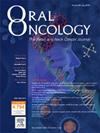Radiation-induced sarcomas of the craniofacial region: A systematic review
IF 4
2区 医学
Q1 DENTISTRY, ORAL SURGERY & MEDICINE
引用次数: 0
Abstract
Background
Radiation-induced sarcomas (RIS) are rare entities that have been studied infrequently in large cohorts, with most data derived from case reports or small series. This study aims to systematically evaluate existing data to synthesize and consolidate current knowledge.
Methods
An electronic literature search was conducted using PubMed and the Cochrane Library. The search included studies and case reports with clinico-histopathological and survival data on craniofacial RIS.
Results
Among 1237 studies identified, 143 studies with 701 patients were included. The average patient age was 48 years, with men nearly twice as likely to develop RIS. RIS had an average latency period of 12 years, with an average radiation dose of 63 Gy. Radiation-induced osteosarcomas (42.1 %) were most common, followed by fibrosarcomas (21.1 %). Nasopharyngeal carcinoma (53.0 %) and retinoblastoma (10.3 %) were the most prevalent primary tumors. 5.4 % of patients received radiotherapy for benign disease. The average latency period in this group was approximately 1.5 times longer than that observed in the group with malignancies; however, the average radiation dose was also approximately 15 Gy lower. Local recurrences occurred after an average of 16 months. The 1-, 2-, and 5-year survival rates were 67.8 %, 47.1 %, and 25.0 %, respectively. Surgical therapy showed the best survival rates (33.3 % after 5 years) while isolated chemotherapy yielded the lowest (0.0 %).
Conclusion
The prognosis for craniofacial RIS remains poor despite aggressive treatment. Surgical intervention is the primary therapeutic approach, but optimal treatment regimens and the role of (neo-)adjuvant therapies require further investigation. This study underscores the complexity of managing RIS and highlights the need for ongoing research to improve outcomes.
求助全文
约1分钟内获得全文
求助全文
来源期刊

Oral oncology
医学-牙科与口腔外科
CiteScore
8.70
自引率
10.40%
发文量
505
审稿时长
20 days
期刊介绍:
Oral Oncology is an international interdisciplinary journal which publishes high quality original research, clinical trials and review articles, editorials, and commentaries relating to the etiopathogenesis, epidemiology, prevention, clinical features, diagnosis, treatment and management of patients with neoplasms in the head and neck.
Oral Oncology is of interest to head and neck surgeons, radiation and medical oncologists, maxillo-facial surgeons, oto-rhino-laryngologists, plastic surgeons, pathologists, scientists, oral medical specialists, special care dentists, dental care professionals, general dental practitioners, public health physicians, palliative care physicians, nurses, radiologists, radiographers, dieticians, occupational therapists, speech and language therapists, nutritionists, clinical and health psychologists and counselors, professionals in end of life care, as well as others interested in these fields.
 求助内容:
求助内容: 应助结果提醒方式:
应助结果提醒方式:


